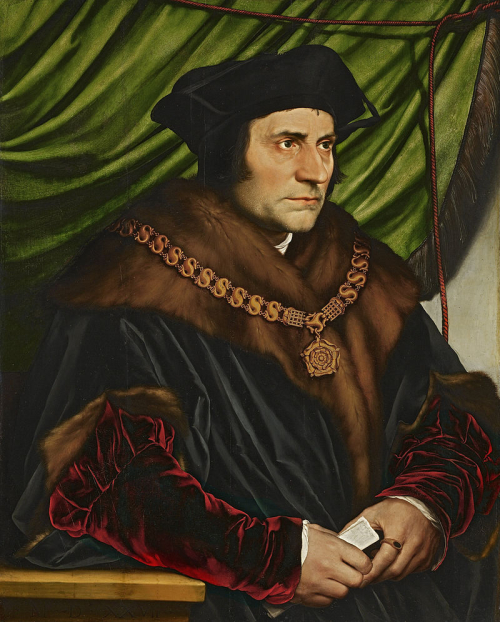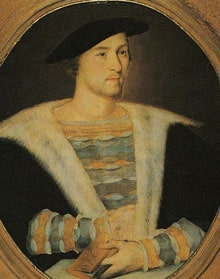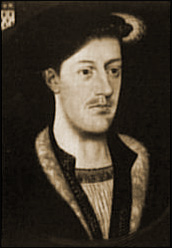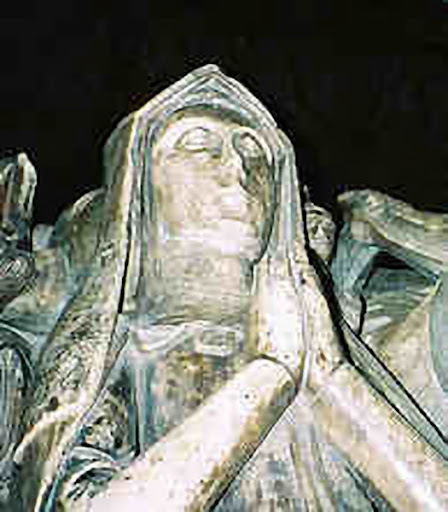As Anne gained importance, Katharine lost privileges. Anne dismissed the Queen's most trusted ladies. One of these ladies was Gertrude Courtenay. Gertrude Courtenay, Marchioness of Exeter, (née Blount; c.1499/1502 – 25 September 1558) was an English Marchioness, married to Henry Courtenay, 1st Marquess of Exeter and a member of the court of Henry VIII of England. She was a godmother to the future Elizabeth I.
In 1531 the Pope forbade Henry to remarry under the pain of excommunication. Henry ignored the pope's warning.
Between 1531-32 Anne's only female friend and lady-in-waiting was Bridget Wiltshire.She was the neighbour, close friend and lady-in-waiting to Anne Boleyn
In the spring 1530 Lady Lisle, wife of Arthur Plantagenet asked Anne for patronage. Honor Grenville, Viscountess Lisle (c. 1493–1495 – 1566) was a Cornish lady whose domestic life from 1533 to 1540 during the reign of King Henry VIII is exceptionally well-recorded, due to the survival of the Lisle Papers in the National Archives, the state archives of the UK. Honor was one of the ladies who attended Anne Boleyn when she travelled to Calais with Henry VIII in 1532.
In 1531 Anne acted as the King's consort, and her ladies-in-waing were Margery Horsman, Jane Ashley, Wriothesley, Anne Savage and Anne Joscelyn.
Margery Lyster or Lister, nee Horsman (died 1565) was an English courtier. She is known as a member of the households of three queens of England; Catherine of Aragon, Anne Boleyn and Jane Seymour.
Jane (Joan) Ashley. Jane is listed as a maid of honor to Anne Boleyn in January 1534. She was definitely a maid of honor to Queen Jane.Anne Berkeley (née Savage), Baroness Berkeley (c. 1496 – 1564) was a lady-in-waiting and companion of Queen Anne Boleyn, the second wife of Henry VIII of England. She was reputed to be one of the witnesses at the secret wedding ceremony of the King and Anne Boleyn which occurred on 25 January 1533.
In November 1532 Anne and Henry married after returning from Calais, but they had another ceremony before a priest in January. Soon after returning to Dover, Henry and Anne married in a secret ceremony on 14 November 1532. She soon became pregnant and as the first wedding was considered to be unlawful at the time, a second wedding service, also private in accordance with the precedents established in The Royal Book, took place in London on 25 January 1533.
Anne was proclaimed Queen in 1533. In May 1533, Anne was escorted by river to the Tower of London where she prepared for her coronation in the royal apartments before riding to Westminster in a triumphant procession. Anne was crowned Queen in Westminster Abbey on 1 June, when she was six months pregnant.
Anne gave birth to a baby girl on 7 September 1533. Henry was disappointed to have a daughter, but hoped a son would follow and professed to love Elizabeth.
On the 11th of July 1533, Pope Clement VII declared that Henry VIII's marriage to Catherine of Aragon was valid and legal. Effectively, it meant that the King of England's marriage to Anne Boleyn was declared null and void.
There were many people against the new Queen. One was Elizabth Barton, the Nun of Kent. Elizabeth Barton (1506 – 20 April 1534), known as "The Nun of Kent", "The Holy Maid of London", "The Holy Maid of Kent" and later "The Mad Maid of Kent", was an English Catholic nun. She was executed as a result of her prophecies against the marriage of King Henry VIII of England to Anne Boleyn.
Anne Shelton, another relative of the Queen's, was appointed Mary Tudor's governess. Anne, Lady Shelton née Boleyn (c. 1483[1] – 8 January 1556) was a sister of Thomas Boleyn, 1st Earl of Wiltshire, and one of the aunts of his daughter, Queen Anne Boleyn. In 1533, Lady Shelton and her sister, Lady Alice Clere,[4] were placed in charge of the household of the King's daughter, Mary. There is some evidence that Lady Shelton was harsh towards the young Mary, often taunting her with Elizabeth's higher status, but it is widely believed that she never resorted to actually hitting the young girl to chastise her.
The Parliament passed the first act of succession, declaring the validity of Henry and Anne's marriage. The Act made Elizabeth, daughter of Henry VIII by Anne Boleyn, who had been born on 7 September 1533, the heir presumptive to the Crown by declaring Mary, daughter of Henry VIII by Catherine of Aragon, a bastard. The Act also required all subjects, if commanded, to swear an oath to recognize this Act as well as the king's supremacy.
Bishop Fisher and Sir Thomas More refused to take the oath and were arrested and executed.
John Fisher (c. 19 October 1469 – 22 June 1535) was an English Catholic bishop, cardinal, and theologian. Fisher was executed by order of Henry VIII during the English Reformation for refusing to accept him as the supreme head of the Church of England and for upholding the Catholic Church's doctrine of papal supremacy.
Sir Thomas More (7 February 1478 – 6 July 1535) was an English lawyer, judge social philosopher, author, statesman, amateur theologian, and noted Renaissance humanist. He also served Henry VIII as Lord High Chancellor of England from October 1529 to May 1532. After refusing to take the Oath of Supremacy, he was convicted of treason on what he claimed was false evidence, and executed.
Anne became pregnant but she lost the child, adn there is another instance when she was told to be pregnant but also miscarried the baby. King Henry took a mistress, possibly Mary Zouche. Anne Gainsford, Lady Zouche (died before 16 July 1548) was a close friend and lady-in-waiting to Queen consort Anne Boleyn.
Jane Boleyn, Anne's sister-in-law, was banished from court. In the summer of 1534, having discovered that Henry VIII had a new mistress who was an enemy of Anne's, Anne and Jane together plotted her removal. This plan actually resulted in Jane's banishment from court.
Mary Boleyn married William Stafford, and that is the reason why she was banished from court because she had committed mesaliance. Sir William Stafford, of Chebsey, in Staffordshire (c. 1508 – 5 May 1556) was an Essex landowner and the second husband of Mary Boleyn. Nonetheless, Mary and Stafford married in secret in 1534. When the marriage was discovered after Mary became pregnant, the couple were banished from court.
King Francis I sent his ambassador to talk to Henry because he wanted his son to marry Mary Tudor, which didn't sit well with Anne.
On January 7 1536, Katharine of Aragon died at Kimbolton Castle. The following day, news of her death reached the king. At the time there were rumours that she was poisoned. On the day of Catherine's funeral, Anne Boleyn miscarried a male child.
Around this time King Henry started a relationship with Jane Seymour. Jane became a maid-of-honour in 1532 to Queen Catherine, but may have served her as early as 1527, and went on to serve Queen Anne with her sister Elizabeth. The first report of Henry's interest in Jane was in February 1536, about three months before Anne's execution.
With the closeness between Henry and Jane, the Seymour family ascended in power. Edward Seymour was promoted to gentleman of the Privy Chamber. Edward Seymour, 1st Duke of Somerset, 1st Earl of Hertford, 1st Viscount Beauchamp (1500 – 22 January 1552) was an English nobleman and politician. He was the eldest surviving brother of Queen Jane Seymour.
The end of Anne Boleyn started when some men, alleged to have had relations with her, were arrested and questioned. One was Henry Norris. Henry Norris (c. 1482 – 17 May 1536) was an English courtier who was Groom of the Stool in the privy chamber of King Henry VIII. Norris was accused of being solicited by Anne at Westminster on 6 October 1533, and of adultery on 12 October and again at Greenwich in November.
Anne was taken to the Tower and accused of adultery. Anne was arrested on 2 May 1536.
Her brother, George, was also arrested. George Boleyn, Viscount Rochford (c. 1504 – 17 May 1536) was an English courtier and nobleman who played a prominent role in the politics of the early 1530s as the brother of Anne Boleyn. George was charged with incest with the Queen and plotting with Anne to kill the King.
There were more arrests: Francis Weston, William Brereton, Thomas Wyatt and Richard Page.Sir Francis Weston (1511 – 17 May 1536) was a gentleman of the Privy Chamber at the court of King Henry VIII of England. He became a friend of the king but was later accused of high treason and adultery with Anne Boleyn, the king's second wife.
William Brereton, c. 1487/1490 – 17 May 1536, was a member of a prominent Cheshire family who served as a courtier to Henry VIII. In May 1536, Brereton was accused of committing adultery with Anne Boleyn.
Sir Thomas Wyatt (1503 – 11 October 1542) was a 16th-century English politician, ambassador, and lyric poet credited with introducing the sonnet to English literature.In May 1536, Wyatt was imprisoned in the Tower of London for allegedly committing adultery with Anne Boleyn. He was released later that year thanks to his friendship or his father's friendship with Thomas Cromwell, and he returned to his duties.
Sir Richard Page (died 1548) was an English courtier. He was a gentleman of the Privy Chamber at the court of Henry VIII of England, and Vice-Chamberlain in the household of Henry VIII's illegitimate son, Henry FitzRoy. Page was imprisoned in the Tower of London in 1536 during the downfall of Anne Boleyn.
Four women tended to Anne in the Tower: Mary Kingston, Margaret Coffin, Lady Boleyn (Anne's aunt) and Mrs Stoner.
Mary Scrope (died 25 August 1548) was an English courtier. As the wife of Sir William Kingston, Constable of the Tower of London, she was in attendance on Anne Boleyn during the Queen's brief imprisonment in the Tower in May 1536, and both she and her husband were among those who walked with the Queen to the scaffold.
Margaret Dymoke (born c. 1500) was a lady-in-waiting at the court of Henry VIII of England. In 1536 five women were appointed to serve Queen Anne while she was imprisoned in the Tower and to report to Sir William Kingston, the Lieutenant of the Tower, and through him to the King's chief minister, Thomas Cromwell, all that the Queen said. These women included Lady Margaret.
Elizabeth Chamber, better known as Elizabeth Stonor (died after 8 December 1602), was an English courtier. She is remembered as the wife of Sir Walter Stonor, and was one of the women chosen to serve Anne Boleyn, the king's second wife, during her imprisonment in 1536.
The woman who first accused Anne was the Countess of Worcester. Elizabeth Somerset, Countess of Worcester (died 1565) was a lady-in-waiting to Anne Boleyn and the main informant against her. In 1536, she testified against Anne Boleyn, claiming she engaged in numerous adulterous acts with a handful of men including Henry Norris, Mark Smeaton, and George Boleyn, 2nd Viscount Rochford, the queen's brother.





























No comments:
Post a Comment